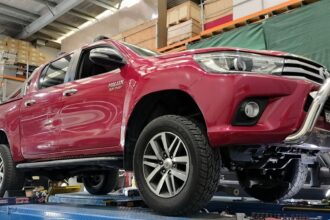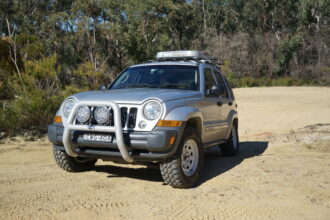The new engine slotting in under the bonnet of Ford’s new 4WD products has caused a stir. No doubt, many don’t like the cubes available. Ford doesn’t buy it, and they reckon this new engine is right up at the point end of efficiency, power and durability. It’s an all-new design, with some pretty interesting engineering happening. Here’s some of the stuff we found most interesting:
10mm offset crankshaft: Rather than sitting directly below the piston and combustion chamber, a slightly offset crankshaft deals with less side-to-side movement. The piston is being pulled in less of an arc by the crankshaft’s rotation, reducing friction and side loads.
Two turbochargers, of the Borg Warner variety. They are set up sequentially, with one low-pressure and one high-pressure unit. The low-pressure turbo kicks in early and hard lower in the rev range, and then gets bypassed to allow the bigger, high-pressure unit to kick in. The turbos are a bit smaller, but can spin up to 240,000rpm. The turbines are made from Inconel, an austenitic nickel-chromium-based superalloy (ahem) that is so good at handling heat and pressure it’s used in rocket engines.

Belt-in-oil drive: The Ford Bi-Turbo timing and oil pump is driven by a belt setup sitting in the sump, partially immersed in oil. This is another drive towards less friction losses and increased refinement, but Ford think it’s just as tough as a timing chian. The belts are a new, special high-strength glass cord that is touted to last like a chain, and as long as the rest of the engine. In other words, you won’t have to replace a belt every 100,000 kays or so.
Read our 2019 Ford Everest Review here
Integrated intake manifold: Rather than pipework running outside the engine that port the air into the cylinder, this is all included inside the cylinder head. This reduces the footprint of the already small engine, but also gives much more control over the incoming air charge. In fact, it’s engineered to give a clockwise swirl in cylinders 1 and 2, and then go anticlockwise in cylinders 3 and 4. Much of the exhaust and the EGR system is integrated into the cylinder head, as well.
Very hectic fuel injectors: Piezeoelectric injectors spray fuel out of 8 holes the width of a human hair, up to six times per combustion cycle at very high pressures. This lets them control as little as 0.8 milligrams of diesel, about 1 grain of sugar in size, ridiculously precisely. Check the inside of your jerry cans, and don’t forget about changing the fuel filter!
It’s capable of more power: Fitted to the Ranger, Raptor and Everest, the Bi-Turbo motor makes 157kW @ 3,750rpm and 500Nm @ 1,750-2,500rpm, both improvements over the 3.2-litre unit. Ford are bringing the Endura/Edge softroader to Australia, and it’s sporting a 2.0-litre BiTurbo diesel that makes 175kW. They haven’t quoted torque yet, so might be robbing Peter to pay Paul, so to speak.

Adblue: Yep, it’s all there. The nasties in the exhaust gets treated almost as soon as it leaves the block, with a catalyst, DPF (diesel particulate filter) and SCR (selective catalytic reduction, or Adblue to you and I) mounted up very, very high next to the block. No more worries about tall grass, and goodbye underbonnet space!
Cast-iron block: I was kind of expecting some special material they fly in from Saturn, but no. Good old-fashioned cast iron for the block. This would help dull the noise and vibrations, as well as dealing with heat well, at the cost of weight. Will this setup go the distance in a 4X4? Ford reckons it will, and tell us they have done the equivalent of around 5.5 million kilometres of durability testing, along customers racking up over 400,000 kilometres on the road. But, proof will no doubt be in the pudding, so to speak. We’ll only know true durability after a decade or so.
What do you think? Will this engine be a winner in the long run? Let us know in the comments below.









